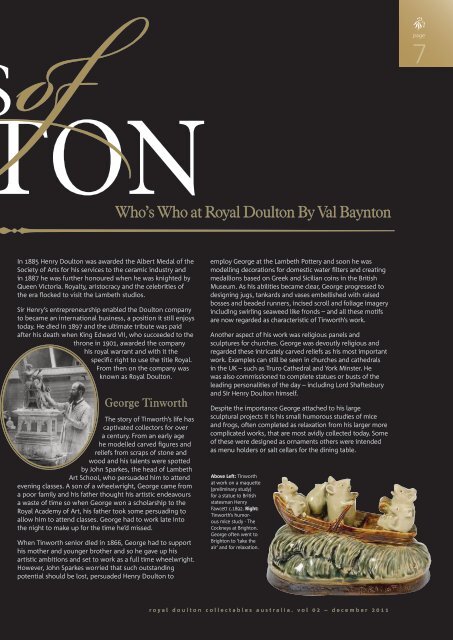Prefer the pdf? - Waterford | Wedgwood | Royal Doulton
Prefer the pdf? - Waterford | Wedgwood | Royal Doulton
Prefer the pdf? - Waterford | Wedgwood | Royal Doulton
Create successful ePaper yourself
Turn your PDF publications into a flip-book with our unique Google optimized e-Paper software.
on<br />
Who’s Who at <strong>Royal</strong> <strong>Doulton</strong> By Val Baynton<br />
In 1885 Henry <strong>Doulton</strong> was awarded <strong>the</strong> Albert Medal of <strong>the</strong><br />
Society of Arts for his services to <strong>the</strong> ceramic industry and<br />
in 1887 he was fur<strong>the</strong>r honoured when he was knighted by<br />
Queen Victoria. <strong>Royal</strong>ty, aristocracy and <strong>the</strong> celebrities of<br />
<strong>the</strong> era flocked to visit <strong>the</strong> Lambeth studios.<br />
Sir Henry’s entrepreneurship enabled <strong>the</strong> <strong>Doulton</strong> company<br />
to became an international business, a position it still enjoys<br />
today. He died in 1897 and <strong>the</strong> ultimate tribute was paid<br />
after his death when King Edward VII, who succeeded to <strong>the</strong><br />
throne in 1901, awarded <strong>the</strong> company<br />
his royal warrant and with it <strong>the</strong><br />
specific right to use <strong>the</strong> title <strong>Royal</strong>.<br />
From <strong>the</strong>n on <strong>the</strong> company was<br />
known as <strong>Royal</strong> <strong>Doulton</strong>.<br />
George Tinworth<br />
The story of Tinworth’s life has<br />
captivated collectors for over<br />
a century. From an early age<br />
he modelled carved figures and<br />
reliefs from scraps of stone and<br />
wood and his talents were spotted<br />
by John Sparkes, <strong>the</strong> head of Lambeth<br />
Art School, who persuaded him to attend<br />
evening classes. A son of a wheelwright, George came from<br />
a poor family and his fa<strong>the</strong>r thought his artistic endeavours<br />
a waste of time so when George won a scholarship to <strong>the</strong><br />
<strong>Royal</strong> Academy of Art, his fa<strong>the</strong>r took some persuading to<br />
allow him to attend classes. George had to work late into<br />
<strong>the</strong> night to make up for <strong>the</strong> time he’d missed.<br />
When Tinworth senior died in 1866, George had to support<br />
his mo<strong>the</strong>r and younger bro<strong>the</strong>r and so he gave up his<br />
artistic ambitions and set to work as a full time wheelwright.<br />
However, John Sparkes worried that such outstanding<br />
potential should be lost, persuaded Henry <strong>Doulton</strong> to<br />
employ George at <strong>the</strong> Lambeth Pottery and soon he was<br />
modelling decorations for domestic water filters and creating<br />
medallions based on Greek and Sicilian coins in <strong>the</strong> British<br />
Museum. As his abilities became clear, George progressed to<br />
designing jugs, tankards and vases embellished with raised<br />
bosses and beaded runners, incised scroll and foliage imagery<br />
including swirling seaweed like fronds – and all <strong>the</strong>se motifs<br />
are now regarded as characteristic of Tinworth’s work.<br />
Ano<strong>the</strong>r aspect of his work was religious panels and<br />
sculptures for churches. George was devoutly religious and<br />
regarded <strong>the</strong>se intricately carved reliefs as his most important<br />
work. Examples can still be seen in churches and ca<strong>the</strong>drals<br />
in <strong>the</strong> UK – such as Truro Ca<strong>the</strong>dral and York Minster. He<br />
was also commissioned to complete statues or busts of <strong>the</strong><br />
leading personalities of <strong>the</strong> day – including Lord Shaftesbury<br />
and Sir Henry <strong>Doulton</strong> himself.<br />
Despite <strong>the</strong> importance George attached to his large<br />
sculptural projects it is his small humorous studies of mice<br />
and frogs, often completed as relaxation from his larger more<br />
complicated works, that are most avidly collected today. Some<br />
of <strong>the</strong>se were designed as ornaments o<strong>the</strong>rs were intended<br />
as menu holders or salt cellars for <strong>the</strong> dining table.<br />
Above Left: Tinworth<br />
at work on a maquette<br />
(preliminary study)<br />
for a statue to British<br />
statesman Henry<br />
Fawcett c.1892. Right:<br />
Tinworth’s humorous<br />
mice study - The<br />
Cockneys at Brighton.<br />
George often went to<br />
Brighton to ‘take <strong>the</strong><br />
air’ and for relaxation.<br />
royal doulton collectables australia. vol 02 – december 2011<br />
page<br />
7


